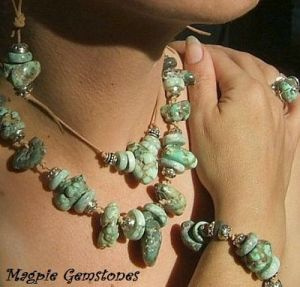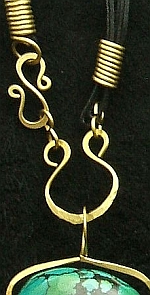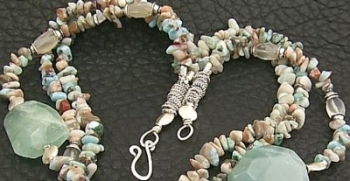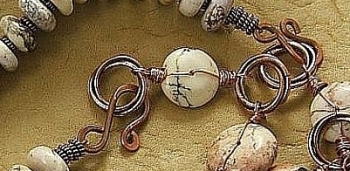Stringing Mediums for Jewelry Making
This article will cover the very basics of types of stringing mediums. Stringing means putting beads on a “string” and adding a closure so it can be worn as a bracelet or a necklace.
It almost always starts this way. You decide you can string up the beads and make jewelry too. Then you are in a quandary wondering what to use and how to finish the piece off. There are many mediums available to string necklace. Leather, cord, silk, fishing line, sinew, tiger tail, and stringing wire. The pro's and cons are listed below.

This necklace is made with Greek Leather and large hole turquoise. The closure is a knotted loop over a rondelle, by Szarka
Leather – You need beads with large holes which is sometimes difficult to find so your design specifics will be limited. The leather will have to be an integral part of your design as well as there will be places it shows through the beads, or maybe most of the necklace with just a few beads.
Leather will eventually break down and break with wear and exposure to water and elements. Naturally processed leather called “brain tan” is the most durable. Greek Leather is very high quality and will last long as well. The thicker the leather you use the stronger and longer lasting it will be. There is suede and round, many different options. Just google leather cord and leather thong to get a feel for your options.

The leather is finished off with a wire wrapped crimp and closed off with a handmade wire S clasp.
Adding a clasp or closure usually also takes a special kind of closure. Crimp over leather closures are a fast and look clean. Wiring your own closure is an option but if you are just starting out you may not have the tools or the skills yet. You can knot the leather onto traditional clasps as well.
I like to double slip knot leather necklaces so they are adjustable. Here is a tut below from ehow . Be sure to cut your cord long enough so that after all the knots are made you can still slide it over your head or you will have no way to get the necklace on.
-
Step 1 Hold one end of the cord in each hand. We'll refer to the end in your left hand as "End A" and the end in your right hand as "End B".
-
Step 2 Use End B to tie a regular knot around End A, about an inch and a half from the end.
-
Step 3 Make a double knot with the loose end of End B.
-
Step 4 Pull the knot along the cord to make sure it slides correctly. If it doesn't, untie the double-knot and repeat Step 3, making sure that you're using the loose end of End B. If you accidentally end up using the end of End A, the knot will not slide correctly.
-
Step 5 Bring End A through the sliding knot by about three inches.
-
Step 6 Use End A to tie a regular knot around the cord about three inches from the other knot. Contrary to what we've done previously, you will be tying this knot on a middle part of the cord rather than an end.
-
Step 7 Make a double-knot using the loose end of End A.
-
Step 8 Check to make sure this knot slides correctly as well.
-
Step 9 Be sure that your knots are snug, but still able to slide. Trim the loose ends on both sides. (Tying beads onto the ends is a nice touch as opposed to trimming them.)

Braided cotton cord finished off with fold over ends that have a built loop to attach a clasp. This is a lobster clasp.
Cord
Similar to leather but found in hemp, cotton, polyester and many other materials. Many of the same design problems and perks as with leather cord. It often is more supple and can be manipulated into beautiful knotted patterns. It comes waxed and unwaxed.
Often a woven cord necklace will have a closure made with a bead on one side and a loop built into the other side which slips over the bead.
Silk
Many similarities to cord and leather with the exception that it is easier to break. Silk is often used on light pearls and knotted between each pearl to protect he pearls from rubbing up against one another. Also, if the strand breaks you will not have all your pearls flying off.
When I have used silk I have made long multi-strand necklaces and knotted a bead here or there. It will not take much weight and beads that may cut through the silk will break the necklace quickly, so heavy beads or those with sharp edges should probably not be strung on silk.
Fishing Line
Many seed beaders use fishing line, a specific kind called fireline. Because they are manipulating the string material back and forth through many light beads it is effective.
Many people who string soft stones such as natural turquoise or Lapis Lazuli insist that fishing line is the best as it will not wear the holes bigger on these softer stones.
Fishing line will stretch over time, and if using harder gemstones they may break down the fishing line so I very seldom use it.
The benefit with fishing line is how easy it is to knot the end into a bead cover with a link attached to make a closure. Many people will burn the end to make a nice compact ball to fit into the bead tips. You can also just tie your line directly onto a clasp.
Just head over to our local bead store and ask about them or google bead tips. Here is a tutorial on using them at All About Jewelry Making.
Sinew
Sinew nowadays is a waxed cotton. It also will break down with heavy beads and hard gemstones. It is nice to use to sew beads onto leather as it functions like thread but much stronger.
It can be used as cord was above.

A necklace strung on stringing wire. It was finished off with two crimp beads and a handmade hook clasp.
Tiger Tail and Stringing Wire
Sometimes people see these as synonymous but there is a difference.
Tiger tail is often 7 fine strings of wire inside a plastic sheath. The stringing wire can be 7 , 19, or 49 strands of wire in a plastic sheath.
The benefits of using this type of string material are that it resists breakage and the higher the number of wires inside the beading wire makes it more and more durable and less likely to break. The higher the number the heavier the beads it will hold. 7 strand will stretch with heavy beads but is great for inexpensive bracelets with light beads.
The downside of using this is the way to end a necklace is a bit more complicated. Some stringing wire can be knotted but most must be crimped. (Crimping can also be used with any of the mediums listed above.)
Trade names for some types of stringing wire include beadalon, softflex, accuflex and more. Everyone has their personal favorite but they are all relatively similar.
Crimping is taking a small tube bead and pressing it into the wire after you have made a loop and you run the wire back through the crimp. So you are using the crimp to make the loop. Here is a free tutorial at About.
I also have a video tutorial I did on how I make crimp beads hold http://www.magpiegemstones.com/crimping.html

This is an example of me double crimping. The crimp beads have been covered with a crimp bead cover.
I personally prefer to use at least two crimp beads on the end of every necklace or sometimes even inside the design to give the beads a better chance of not being lost should the necklace break. Also, a double crimp on the end will give added insurance should one crimp give out.
After the crimp is made it can be covered with a crimp bead cover a large hole bead or a cone.

An example of my crimps being covered with twisted jump rings for a unique effect. It is a triple strand necklace so each side was crimped a total of 6 times, two on each strand. There were a lot of crimps to cover.
Many people do not crimp the way it is shown in the tutorial above. They do what is called a flat crimp. Be sure your wires are not crossed and press the bead flat with flat pliers. It holds better but leaves a sharp spot that may be uncomfortable. I will double flat crimp a very heavy necklace and then cover the crimps with large holed beads.
It is about your personal style. I have seen many necklaces going for top dollar at stores like Nordstrom's which were just flat crimped and the crimps left exposed. It makes jewelry makers squirm but it doesn't seem to stop people from buying them even though that is considered to be an inferior way to end a piece.
Then you have a loop on each end of your necklace where you can add your closure of choice. They are often called clasps and come in spring ring, lobster, S hook, or toggle.
 This is a handmade clasp and the crimps, again, were covered with jump rings.
This is a handmade clasp and the crimps, again, were covered with jump rings.
Sizes of Wire - Not only does stringing wire come in three different amounts of wires inside but they come in different sizes. The mm size is often .14 (very tiny often used for gems with small holes and pearls) .19 (medium size, good all around stringing wire.) and .024 (thick, less supple but stronger for large gemstones or heavy beads.) I prefer to double up the stringing wire whenever possible since I often use very heavy gemstones in my designs.
The plastic sheath will protect the metal from water and the elements so it does not corrode. It will wear down in places eventually or will be broken if your crimping is over zealous.
End Notes
For a piece that is worn continually, all methods should be restrung yearly it is recommended. I personally have not found that to be necessary.
If you know a bead you have will have sharp edges like Bali Sterling or some gemstones it is a good practice to ream them out with a bead reamer to give your necklace a better likelihood of not breaking down.
Have fun exploring different ways to string up a necklace.
Szarka
Comments from readers below
___________________________________
Szarka, I would like to give you some more information on "fishing line". I agree that monofilament fishing lines will deteriorate, stretch and break. The woven fishing lines PowerPro and Fireline are made of polypropylene. They do not stretch and they do not break down. They resist abrasion and you can ruin a good pair of scissors trying to cut them!
Strangely enough, kids Fiskars scissors will easily cut these lines if you hold the line taut while you cut. They come in a multitude of sizes. For seed bead weaving I like 6-10 pound test. They are especially useful with crystals or bugles which can be very sharp and abrasive on the thread.
For stringing, one can use a much higher test line which will be thicker. PowerPro has a nice and is soft and drapey and is hard to put through the eye of a needle. Fireline is a bonded thread and is fairly stiff when you
first start working it. It does soften some with use. Both are easily tied.
Nylon, Nymo, stretches, breaks and is easily cut by crystals and bugles. It frays and I won't use it, even though it comes in a nice array of colors.
Karen
http://newcamellot.blogspot.com
_______________________________________
Szarka -
Both Power Pro and Fireline are made from *polyethylene* which has a strength-to-weight ratio many times higher than steel. *Polypropylene* is more commonly used for containers but is used for fibers sometimes - one
difference between the two is in the stretch in the fibers - polyethylene has almost no stretch when spun.
When you work with Fireline - you'll find this out quickly! Be aware and use caution: NEVER try to break either of these lines - they will both cut your skin before they break! One of the properties of polyethylene is that it is
more resistant to abrasion than Teflon fibers (you know - the stuff they make bullet-proof vests out of?) - great news for those of us who work with crystal!!!
Be aware when using a thread burner with them - the melting point of this material is lower than some other common plastics - they will burn away to nothing instead of balling up neatly if you aren't careful with traditional
knot burning techniques.
Another difference between Fireline and PowerPro - Fireline is braided, then fused - the silhouette is less round, takes up less room in the beads - it actually flattens! I've gotten 10lb test through size 15 beads up to 8
times! No such luck with PowerPro, for me, at least.
These threads are referred to as 'superlines' in the fishing industry - and they are truly super for us, too! Very light, exceptionally strong, they don't break down like monofilament. They don't stay stiff, either - the drape is one reason they are perfect candidates for beading - especially for long strands of seed beads.
I have never encountered a better thread for the lovely, drapey branch and coral techniques - but keeping tension for stitches that need to be more rigid can be challenging - I suggest a higher lb. test to compensate if you
have room in your bead holes. It is really worth it!
Two drawbacks that can be overcome: One is the tendency for the color to come off the line - it is yucky, but if you run the lengths through a rough paper towel a few times, it helps.
The second: they require special knots to stay perfectly secure. That lovely resistance to abrasion means they also resist staying tied in knots, LOL I suggest you visit a fishing site to learn some of these. Here's a good one: http://www.thejump.net/fishing-knots/fishing-knots.htm The knots have applications far beyond just ending thread.
Although Fireline is my personal favorite, PowerPro does have its uses, as I find it to be a bit more stiff - can you tell I love this material?
BTW - go to any fishing shop that specializes in cast fishing, and you will find a wealth of items that beaders can use - Teflon thread comes in really cool colors and wire for tying flies is 34g - in color!!!!
Perri Jackson
"The details are not the details. They make the design." Charles Eames
http://ShaktipajDesigns.etsy.com
http://ShaktiPajDesigns.com
http://facebook.com/ShaktipajDesigns
_____________________________________________-
De nada! I stopped thinking about Fireline as fishing line ages ago, LOL All I see is what kind of jewelry can I make with it! If you want to combine wire and bead work in a mixed media piece - this is THE way to go, as far as
I'm concerned. When the native Americans I know locally aren't using traditional materials, they opt for Fireline - shells and quills don't cut it effectively.
If you make a continuous piece, it would probably garrote you if you got caught on something - so make friends with clasps, LOL
Perri Jackson
"The details are not the details. They make the design." Charles Eames
http://ShaktipajDesigns.etsy.com
http://ShaktiPajDesigns.com
http://facebook.com/ShaktipajDesigns
http:/newcamellot.blogspot.com